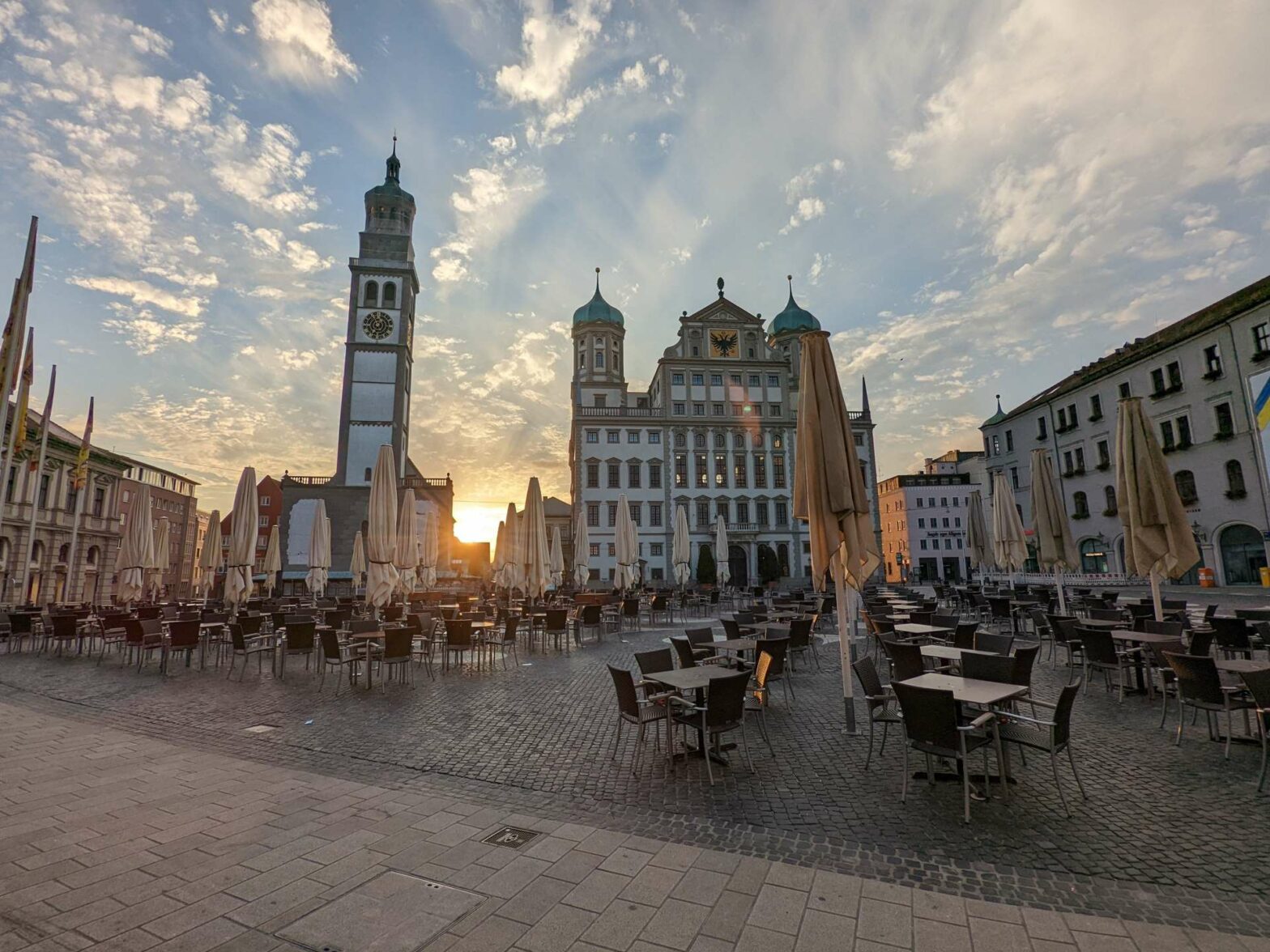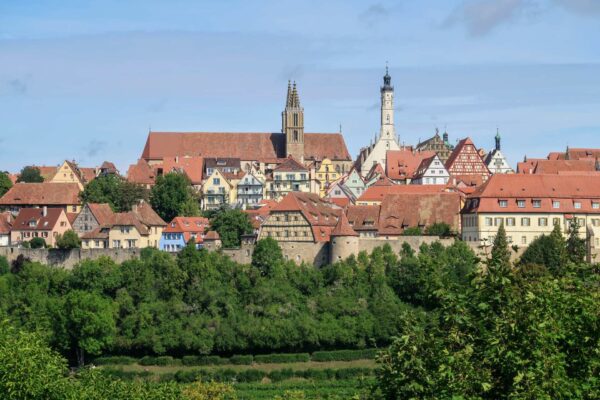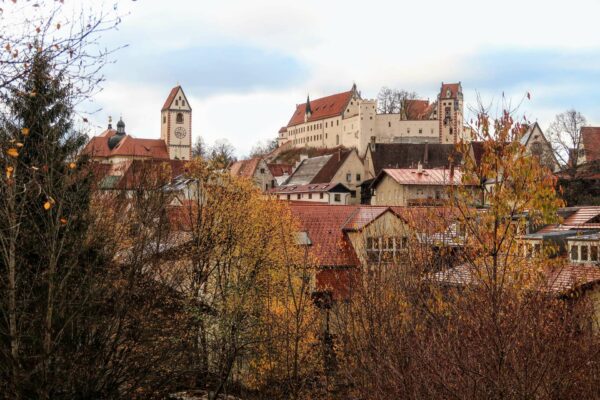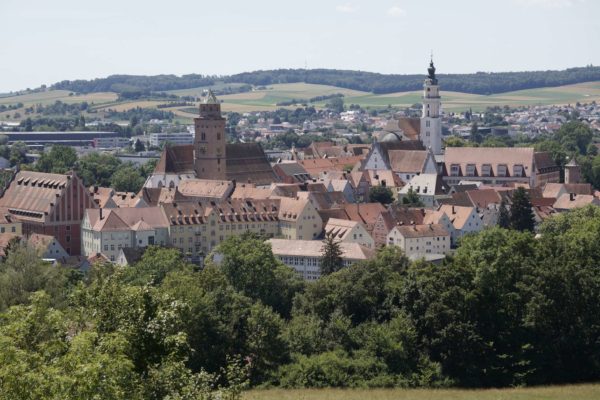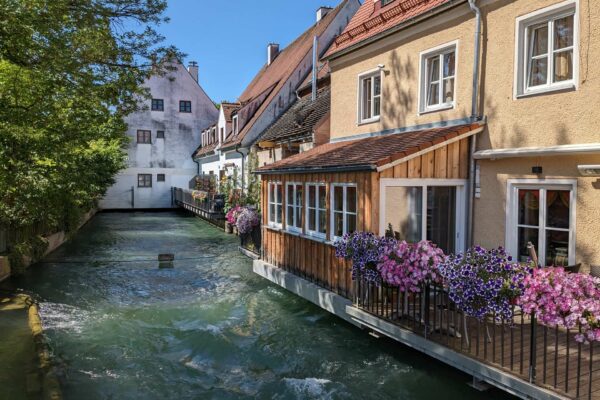By Vicky · Published Nov. 16th, 2022 · Updated Jan. 12th, 2024
When you buy through links highlighted with an asterisk (*) on this site, we may earn a small affiliate commission at no cost to you.
On this Augsburg Walking Tour discover one of the oldest cities in Germany, a great stop-off along the Romantic Road.
Page Contents:
Location
This walk starts from Königsplatz, which is just a few hundred metres from Augsburg Train Station. It’s about 45 minutes from Munich by train.
Augsburg Walking Tour Map
Get the route by downloading the .gpx or .kml file below. For navigation with Maps.me on your mobile phone, simply download the .kml file and open to add it to the Maps.me bookmarks.
Tips for Augsburg Walking Tour
- Read a play by one of Augsburg’s illustrious former residents, Bertolt Brecht – The Threepenny Opera* is his most famous work.
- On the first Sunday of every month, entry to the Augsburg Museums is only €1 for each museum.
- Why not also explore the cute town of Donauwörth or the historic city of Nuremberg, both easily reachable on the train.
- Check out other walks on our Germany Hiking Page.
Top Sights in Augsburg
On this self-guided walking tour you’ll see the main sites and attractions of Augsburg. One day is the perfect amount of time to spend in Augsburg.
- St Anna Kirche
- Augsburg City Market
- Maximillianmuseum
- Rathausplatz
- Augsburg Cathedral
- Bertolt Brecht Haus
- Fuggerei
- Maximilianstraße
- Schaezlerpalais
- Church of St Ulrich
Augsburg Walking Tour Route
This walking tour starts from Königsplatz, where there’s often something going on, for example a biergarten in summer. It’s just a few hundred meters from Augsburg Train Station. Apart from leading you to all the main attractions in town, this walking tour guides you along the nicest historic streets so you can get a feel of the old town.
Directions: Head out of Königsplatz away from the station, along the pedestrian street to the left just after Mcdonald’s. Soon you’ll see a little open area on the right and the back of a church on your left. Head through the gate just after the church to enter inside.
1. St Anna Kirche (St Anne’s Church)
Key Information: Open Mon 12-6pm, Tue-Sat 10-6pm and Sun 3-5pm. Free entry to both the church and the Martin Luther museum.
St Anna Kirche (Website, Tripadvisor Reviews*) is a lovely church in Augsburg with a rather ornate inside. When you first enter, you’ll be in the Fuggerkapelle, an old and quite evocative section of the church made of stone, with frescoes on the walls. This is where members of the rich Fugger banking family were buried.
Upstairs there’s a small museum, the Lutherstiege, about the Reformation of Martin Luther who stayed here in the early 16th century. It’s quite interesting and part of it is on the balcony inside the church, so you get a different perspective of the ornate interior.
Directions: Leave through the church gate and take the second left through an archway into the busy market.
2. Augsburg City Market
Key Information: Open Mon-Fri 9:30am–6pm, Sat 7am–2pm and closed Sundays. On Mondays fewer stalls are open.
The Augsburg City Market (Website, Tripadvisor Reviews*) sells fresh fruit and vegetables, meats, cheeses, flowers and more. There are also several food and drink stands. It’s rather a posh market rather than a cheaper market and you can find many wonderful unique products.
Directions: Head out of the market area and right along the street to the back of St Anna’s Church. Head left through the little square and left into a square known as Fuggerplatz.
3. Maximillianmuseum
Key Information: Open Tue-Sun 10a,-5pm. Entry is €7/5.50 for adults/reductions.
The Maximillian Museum (Website, Tripadvisor Reviews*) takes up one side of Fuggerplatz in a converted old house. It contains many objects from Augsburg’s history, including architectural models, many coins and artworks. There’s a posh cafe in the courtyard, which contains several large sculptures in bronze.
Back out on Fuggerplatz, you can see a statue of Mr Fugger, erected by King Ludwig I of Bavaria. Admire the other stately buildings and continue left towards the large square.
4. Rathausplatz
Key Information: Town Hall open daily 10am-6pm, €2.50 to visit the Golden Hall. Perlachturm open Apr-Nov, 10am-6pm, €1.50/1 to climb the tower.
The Rathausplatz is the grand main central square of Augsburg, at the centre of the Altstadt. There’s a great Christmas Market here in December. In the centre of the square is the Augustusbrunnen, a fountain with a central statue of Augustus Caesar. The four statues on the outer ring represent four local rivers, all of which are important in Augsburg’s water management system.
The Rathaus, or Augsburg Town Hall (Tripadvisor Reviews*) dominates the square. Although built way back in 1615, it’s in very good condition as it was significantly rebuilt following damage during the Second World War. You can enter the Rathaus to visit the Goldener Saal (Golden Hall). It’s an amazing overly-decorated former town meeting and banqueting hall. There’s a guide in English and you get some nice views over the town square and the buildings on the other side. Next door to the Rathaus is the Perlachturm (Tripadvisor Reviews*), a tower you can climb up for great views.
Tourist Information & World Heritage Centre
Key Information: Tourist Information open daily, weekdays 9am-5pm, Saturdays 10am-5pm and Sundays 10am to 3pm. World Heritage Centre (free entry) open Tue-Sat 10am-4:30pm and Sunday 10am-4pm.
Check out the Tourist Information, on one side of Rathausplatz. They have lots of interesting leaflets and information about events going on in Augsburg. Next to the Tourist Information is the World Heritage Centre, where you can learn all about the water management system of Augsburg. It’s actually super interesting and the staff are happy to explain the exhibits in English. There are some short videos about the different aspects of the water system, and English captions to most exhibits.
Directions: Leave the Rathausplatz along the street heading left from the tall Perlachturm. Cross a busy road and soon you’ll see the cathedral.
Discover Walking Tours of other Bavarian Cities
5. Augsburg Cathedral
Augsburg Cathedral (Website, Tripadvisor Reviews*) is on a hill in a peaceful area full of small parks on the northern side of town. Its official name is Dom Mariä Heimsuchung and it was founded in the 10th century. Expanded over the next few hundred years, it now has mainly Gothic architecture but looks quite higgledy-piggledy from the outside. Inside, there are some nice frescoes, a crypt, and lovely stained-glass windows from the 12th century. Just outside the church, you can see the remains of a former church, along with several Roman finds from around town.
Detour: If you’re interested, continue around the cathedral and along the road to the Leopold Mozart House (Open Tue-Sun 10:00-17:00. Adults/reductions €6/5). This little museum (Tripadvisor Reviews*) is about the father of the famous Mozart. You can learn about and listen to music, with a grand piano and much more.
Directions: Leave the cathedral towards town and take the first left to wander along some nice quiet streets. Head straight on down some steps and left to look at the Zirbelnuss Canal Bridge, a double-crossing of water channels. Retrace your steps a short distance and turn left towards town. At the T-junction turn right, then take the first left, using a tunnel to cross the busy road.
You’ll soon see the Stadtmetzg Augsburg, an old butchery in a fancy-looking building on a small square. Two water channels flow beneath the butchers, one for cooling the meat and one to take away any meat offcuts and waste.
Directions: Head left from the little square and take the first left. The next stop is at the end of the street on your left.
6. Bertolt Brecht Haus
Key Information: Open Tue-Sun 10:00-17:00. Entry price for adults/reductions is €2.50/2.00. Exhibits in German.
The Bertolt Brecht Haus (Website, Tripadvisor Reviews*) is located in a cute street that always remains cold in hot weather due to the abundance of shade and the fast-flowing brook that babbles through. Bertolt Brecht (a playwright whose most famous work is The Threepenny Opera*) was born and lived in Augsburg, spending his first two years in the house that now contains a small museum. There are some photos of his life and details of his history and works. Unfortunately the exhibits are all in German.
Directions: Head right and right again back to the main road. Turn left and in a few hundred metres you’ll see the Fuggerei on the right of the street.
7. Fuggerei
Key Information: Open every day from 9 am to 8 pm. Entry is €6.5/5.5/3 for adults/reductions/children and €12 for a family ticket. Pick up an English leaflet at the entrance.
The Fuggerei (Website, Tripadvisor Reviews*) is one of the top things to do in Augsburg. It was, and still is, a place for poor Catholics to live. Jakob Fugger, a rich banker from the early 16th century, built the Fuggerei as an act of charity. Today, over 500 years later, 200 people still live in the Fuggerei, paying rent of only 1 Rhenish Guilder, or €0.88 per year! Its age makes it the oldest social housing complex that still exists today.
Once inside the Fuggerei, you can wander up the cute cobbled, car-free lanes and look at all the little cottages. Bear in mind that people do still live here, so don’t be too loud or intrusive. It’s a rather peaceful place, and residents work part-time in the community.
A few of the houses are open to the public and you can go inside. There’s a small museum about the Fuggerei, and in an underground war bunker there’s a little bit about Augsburg during the Second World War. Most interestingly, you can go in a house which shows how it would have been hundreds of years ago, and another one which shows the modern apartments they are today.
Directions: Head back along the main road and turn left at the next main junction. Take the first right and walk through an old residential part of Augsburg, with peaceful streets and historic houses. Once you reach the main square, turn left along the broad street.
History of Augsburg
On this walking tour you can discover the history of Augsburg. The town was founded by the sons of Augustus Ceaser roughly 2000 years ago – see the Roman ruins by the cathedral. From the 13th century, it gained the status of a Free Imperial City. Trade boomed and two famous banking families lived here, the Fuggers (after which the Fuggerei is named) and the Welsers.
In the 16th century, religious wars led to the decline of trade and with it, the decline of the city – learn about Luther and the Reformation at St Anna Church. From 1806 Augsburg became part of the Kingdom of Bavaria and in 2019 the city gained UNESCO status for its waterworks management system, which you can learn about at the World Heritage Centre on the main square.
8. Maximilianstraße
Maximilianstraße is one of the main streets in Augsburg and is lined by many shops and restaurants. It’s rather wide and the buildings on either side are colourful and interesting.
After a short distance walking down the street, you’ll see a very colourful house on the left. This is the Weberhaus (Tripadvisor Reviews*). This used to be the home of the Augsburg Weaver’s Guild, and today it continues the wool theme with a very expensive shop selling knitwear from Italy.
Opposite the Weberhaus is Kirche St. Moritz (Website, Tripadvisor Reviews*). It’s rather plain and minimalist on the inside, with not much decoration. However, it’s bright and peaceful, and a quiet place in the centre of Augsburg, perhaps to rest after walking.
Directions: Continue further along the street and look out for the Schaezlerpalais opposite the fountain on the left.
9. Schaezlerpalais
Key Information: Open Tue-Sun 10am-7pm. Adults/reductions €3.5/3. Audio guide €3.
The Schaezlerpalais (Website, *) is a well-preserved grand building from the 18th century, the former house of a rich citizen. The palace contains ornate rooms, including a Rococo ballroom, and houses many paintings. The audio guide explains the rooms and exhibits – it’s a bit long but without it you might be slightly lost.
Directions: Walk to the big church at the end of the street.
10. Church of St Ulrich and St Afra
Key Information: Open 7:30-18:45 every day. Free entry.
The Church of St Ulrich is a Protestant church, while the adjoining Basilica of St Ulrich and St Afra (Tripadvisor Reviews*) is Catholic. The catholic church is much larger and topped with turquoise onion domes. Both churches were built at the same time and intentionally next to each other to show solidarity and understanding of each other’s beliefs. This was at a time when religious wars were raging around Europe, so it was probably a good idea.
This is the end of the Augsburg Walking Tour. From here you can continue on the detour suggested below, or head back into the main part of town and/or to the train station.
Detour: If you’re interested, now would be the time to walk to the Augsburg Puppenkiste, and/or the Waterworks at the Rotes Tor, or to the Jewish Museum near the station.
Augsburg Puppenkiste (Theatre-Puppet) Museum
Key Information: Open Tue-Sun 10am-7pm. Entry for adults/children is €5/3.30.
The Augsburg Puppenkiste Museum (Website, Tripadvisor Reviews*) is a puppet museum. Many of the puppets were on German TV in the 1990s and they play some of the tv shows inside. Most of the displays are in German, so it’s only worth visiting if you’re really into puppets.
Waterworks at the Rotes Tor
Waterworks at the Rotes Tor is a collection of old buildings where the water management of Augsburg took place for over 400 years, starting in 1416. Augsburg has now got UNESCO recognition for its unique water management system. It mainly dates back to the Medieval Period and most of it survives to this day.
Jewish Museum
Key Information: Open Mon-Thu 9am-6pm, Fri 9am-4pm, Sun 10am-5pm. Entry price for adults/reductions is €6/3.
The Jewish (Jüdisches) Museum (Website, Tripadvisor Reviews*) is in the Synagogue Augsburg, an art-deco building from the early 20th century. The museum contains artefacts from other synagogues across the region.
Attractions Further Afield
Augsburg Botanical Garden
Key Information: Open from 9 am to sunset every day. Adults/reductions €3.5/3.
Augsburg Botanical Garden (Website, Tripadvisor Reviews*) is best to visit in late spring or summer when the plants are out. There are also tropical greenhouses and a Japanese garden. It’s a good place to have a picnic and there’s a Biergarten and a playground for kids. You could spend a few hours here if you’re not in a rush or quickly walk around in about one hour.
For more walking tours and hikes in Germany, see our Germany hiking page.
FAQS: Augsburg Walking Tour
There’s lots to do in Augsburg so it’s worth visiting, but it isn’t quite as cute as other Bavarian towns such as Bamberg or Rothenburg ob der Tauber.
Augsburg is known for being the oldest city in Bavaria, and one of the oldest in Germany, having been founded by the nephews of Augustus Ceasar.
The best thing to do in Augsburg is a self-guided walking tour of the city to see all the famous sights, such as suggested in this guide.
One day is enough time to spend in Augsburg to see the main sights.

